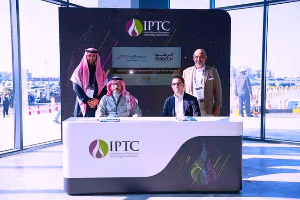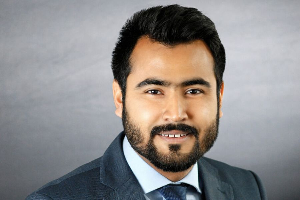Middle East prepares for Green hydrogen revolution

Green hydrogen is rapidly becoming a focal point of the energy transition discussion in many areas of the world, and the Middle East and North Africa (Mena) is no exception as governments seek to diversify their energy sectors and economies. Energy & Utilities delves into the potential for green hydrogen in the region and what needs to be done to turn plans into reality.
Green hydrogen is rapidly becoming a focal point of the energy transition discussion in many areas of the world, and the Middle East and North Africa (Mena) is no exception as governments seek to diversify their energy sectors and economies.
The potential for green hydrogen in the region was given stark focus in July when it was announced that US-based Air Products and the local Acwa Power had signed a memorandum of understanding (MoU) to develop a $5bn hydrogen-based ammonia plant in Saudi Arabia.
The $5bn hydrogen-based plant will be located at the planned $500bn Neom development on the Red Sea Coast of the kingdom, one of the kingdom’s Public Investment Fund (PIF’s) key megaprojects planned to diversify the country’s economy away from a dependence on oil.
The project will be powered by more than 4GW of renewable energy and will be able to produce 1.2 million tonnes per year of ammonia. The plant will produce 650 tonnes of hydrogen daily, Air Products revealed in a statement released on 7 July.
Massive potential
According to experts in the field, the potential for green hydrogen in the Gulf is vast given the excellent renewable energy resource, abundant availability of land, stable economic climate, and physical and intellectual infrastructure dealing with large scale oil, gas and power projects.
“In North Africa, a major boost was given by the ambitious European Hydrogen Strategy, which was released a couple of weeks ago, and which foresees an important role for hydrogen imports, specifically mentioning Ukraine and North Africa,” said Frank Wouters, Global Lead of Clean Hydrogen at Worley, based in the UAE.
“Not only have countries, such as Morocco, already a solid vision on green hydrogen and green ammonia, but for them, the potential to eventually export these products could become a major source of revenue in the future.”
Green hydrogen is projected to grow rapidly in the coming years, with global energy leaders identifying it earlier this year as a potential key accelerator of the energy transition and enabler for a wider global decarbonisation. Francesco La Camera, Director-General of the International Renewable Energy Agency (Irena), had described it at the agency’s 10th Assembly in January as gaining unprecedented political and business momentum, with a number of policies and projects expanding rapidly around the world.
Projects
The UAE’s Environment Minister, Dr Thani al-Zeyoudi, had also said that, with further investment, hydrogen production could become cost competitive in the next five years. “In the UAE, we are building the region’s first solar-driven hydrogen electrolysis facility,” he had said.
Wouters spoke of some of the technologies being developed so far. “Some of components to produce green hydrogen are solar panels and wind turbines, reverse osmosis (RO) for purified water and electrolysers,” he explained. “All these technologies are proven and solar, wind and RO have become increasingly cost competitive over the last years. Given the specific situation in the Gulf, seawater desalination is required.”
Although RO is proven, he said it produces brine which should ideally not be discharged back into the sea. Although solutions for zero brine discharge are currently being studied and piloted, Wouters called for more work in the field. “The centerpiece of water electrolysis is the electrolyser, a century-old technology,” he added. “However, given the limited current demand and manufacturing scale, electrolysers are still expensive. If demand picks up, efficiencies can increase, and larger scale and better supply chain management will reduce cost.”
Dubai Electricity and Water Authority (Dewa) is currently finalising the construction of an electrolysis system in the Maktoum solar park, being developed by Germany’s Siemens, which will help it better understand the production of hydrogen connected to a solar farm. The produced hydrogen will be used in fuel cell vehicles for Expo 2020 next year. “In the recast of the five-year energy strategy, the UAE will, for the first time, incorporate hydrogen as an energy vector,” Wouters noted. “The updated energy strategy will be released next year.”
Several UAE entities are also currently studying green hydrogen opportunities, such as in Ruwais, where Wouters said a lot of hydrogen is already being used for the production of fertilisers and in the refineries. “Lastly, the production of hydrogen in conjunction with the nuclear power plants in Barakah may provide an opportunity to solve the baseload conundrum, especially in winter,” he added.
Other projects are also sprouting up. In the framework of the Desertec Industrial Initiative (Dii), launched in 2009 as a market enabler in Germany for exploring the potential of renewables in the desert areas of the MENA region, the MENA Hydrogen Alliance was recently launched to advance the hydrogen agenda in the region. Its aim is to accelerate the development of value chains for green molecules in the region and bring together private and public sector actors and academia.
“Under the umbrella of Desertec 3.0, Dii Desert Energy acts as impartial advisor to elaborate business cases and to educate different stakeholders on all aspects of producing, transporting and using green hydrogen and other green molecules,” said Cornelius Matthes, Chief Executive of Dii Desert Energy. “This includes exporting green molecules to world markets, including Europe.”
Following the first consultation with stakeholders at the World Future Energy Summit in Abu Dhabi in January, hosted by Masdar, and its subsequent official launch at InterSolar Middle East two months later, the third meeting of the MENA Hydrogen Alliance in May provided a review on recent activities, as well as a discussion on the alliance’s work until the end of 2020. “This particular edition focused on connecting MENA to Europe by fostering a regional partnership between Europe, North Africa and the Middle East to accelerate the deployment of green hydrogen projects and local value chains,” Matthes explained.
“Dii Desert Energy, together with the MENA Hydrogen Alliance, have been working on different papers and studies on 2020, such as the 2X40 GW initiative led by Hydrogen Europe, which has been officially adopted in the European Hydrogen Strategy presented on July 8.”
An extensive study on the potential for green hydrogen production in eight MENA countries and ways to transport to Europe has also been completed for a European industrial group, which is looking to source GW scale green hydrogen in the mid term to decarbonise its own activities.
Originally led by the key Dii partners, such as Acwa Power, Neom, thyssenkrupp, Masdar, MAN Energy Solutions, MASEN, Fraunhofer and others, the MENA Hydrogen Alliance recently brought on board a wave of new members like universities, public sector players and additional private sector actors like Mytilineos, Haldor Topsoe, Post Scriptum or ib vogt.
“An ambitious workplan for the second half of 2020 is lined up from looking more in depth on business cases with the new LCoH model, the infrastructure and transport aspects and elements like certification,” Matthes added. “New partners are welcome to join the Alliance.”
According to Wouters, more and more countries and regions in the world are aiming for carbon neutral economies until 2050. “There are a few options to achieve that reliably and cost effectively and the two major energy carriers involved in that transition are electricity and hydrogen,” he explained.
“Electricity currently comprises 20 percent of final energy and that will grow to 50 percent. There are few options that will be as competitive and scalable as hydrogen to cover the remaining 50 percent.”
He mentioned that the European Union’s hydrogen strategy would already take hydrogen to some 25 percent of final energy. “I personally believe that when we start producing and using hydrogen at scale, this development will accelerate, and we will end up with a higher share,” he concluded. “Having migrated from biomass to coal to oil and gas, hydrogen has the potential to become the final fuel”.
Energy & Utilities - Middle East and Africa Market Outlook Report 2024.
This must-have report for industry players offers a thorough understanding of the latest developments, challenges, and opportunities in the region, supported by data, analysis, and expert insights.








